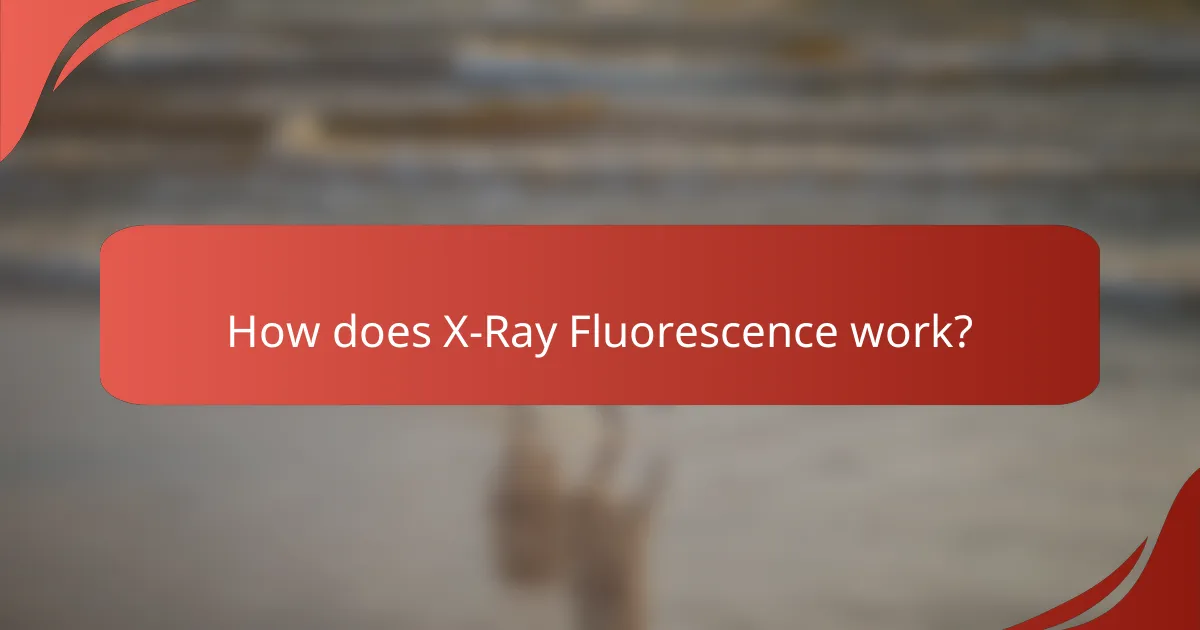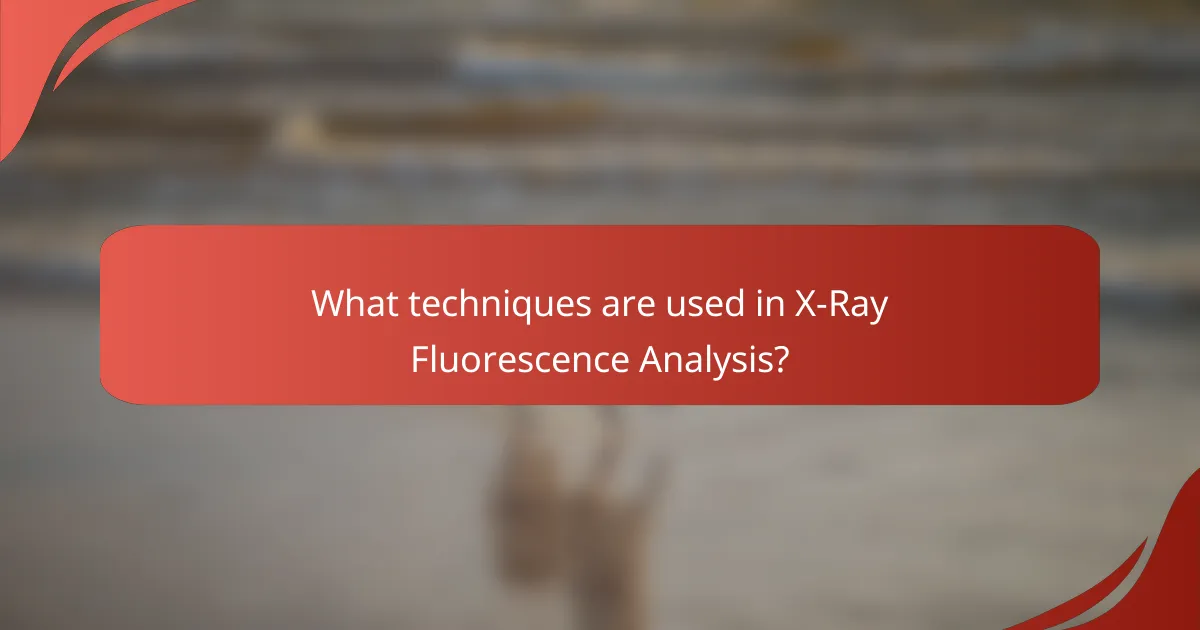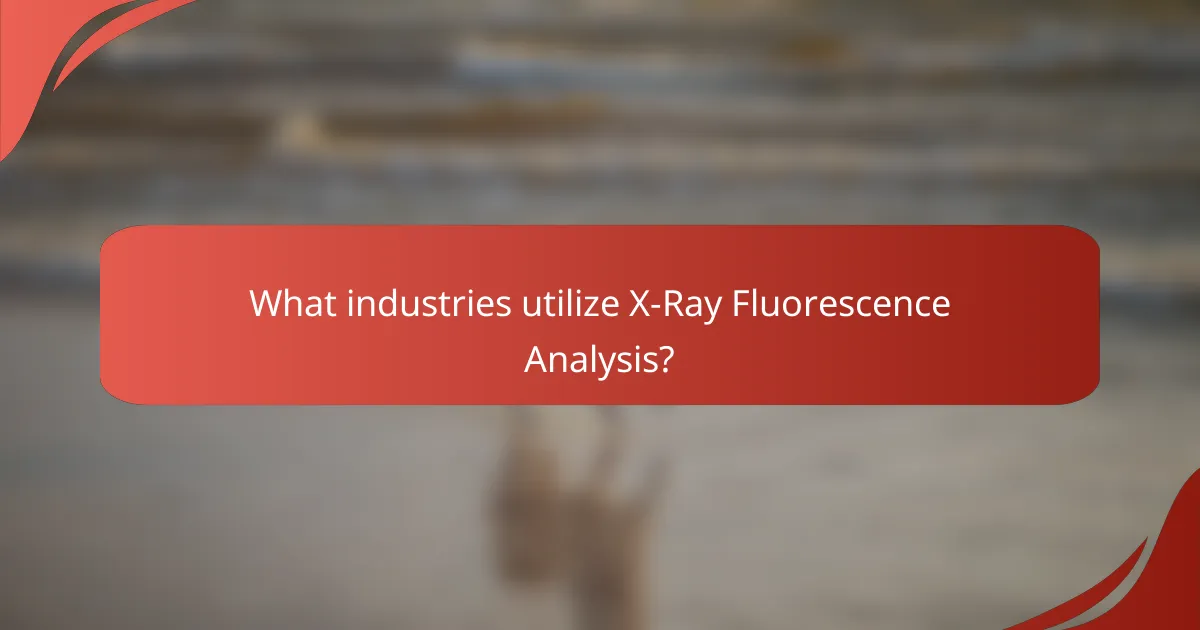X-Ray Fluorescence (XRF) Analysis is a powerful non-destructive technique used to accurately determine the elemental composition of materials. By exciting atoms in a sample with X-rays, it generates secondary X-rays that reveal the specific elements present. The method offers rapid results and high precision, making it a preferred choice across various industries for mineral composition assessment.

What are the benefits of X-Ray Fluorescence Analysis?
X-Ray Fluorescence (XRF) Analysis offers several advantages, including its non-destructive nature, rapid results, and high accuracy. These benefits make XRF a preferred method for assessing the mineral composition of various materials across multiple industries.
Non-destructive testing
XRF analysis is a non-destructive testing method, meaning it does not alter or damage the sample being analyzed. This feature is particularly valuable in applications where preserving the integrity of the material is crucial, such as in art conservation or geological samples.
By using XRF, technicians can obtain essential data without compromising the sample’s future usability. This is especially important in industries like archaeology, where artifacts must remain intact for study and display.
Rapid results
One of the key benefits of XRF analysis is the speed at which results can be obtained. Most analyses can be completed in a matter of minutes, allowing for quick decision-making in various applications.
This rapid turnaround is beneficial in industrial settings, where timely data can influence production processes and quality control measures. For instance, manufacturers can quickly assess raw materials to ensure compliance with specifications.
High accuracy
XRF analysis provides high accuracy in determining the elemental composition of materials. The technique can detect elements from sodium to uranium, making it suitable for a wide range of applications.
With proper calibration and sample preparation, XRF can achieve accuracy levels that are often within a few percent of the actual concentrations. This precision is critical in sectors like mining, where accurate mineral content assessment directly impacts economic viability.
Wide elemental range
XRF is capable of analyzing a broad spectrum of elements, typically from light elements like magnesium to heavy metals such as lead and mercury. This wide elemental range makes it versatile for different industries, including environmental monitoring and material science.
For example, in environmental studies, XRF can be used to detect trace metals in soil or water samples, providing crucial data for assessing contamination levels and compliance with environmental regulations.
Cost-effective
XRF analysis is often more cost-effective compared to other analytical methods, particularly when considering the speed and non-destructive nature of the technique. The initial investment in XRF equipment can be offset by the savings in sample preparation and analysis time.
Additionally, since XRF can analyze multiple elements simultaneously, it reduces the need for multiple tests, further lowering costs. This efficiency is advantageous for businesses looking to optimize their analytical processes while maintaining quality standards.

How does X-Ray Fluorescence work?
X-Ray Fluorescence (XRF) is a non-destructive analytical technique used to determine the elemental composition of materials. It works by exciting atoms in a sample with X-rays, causing them to emit secondary X-rays that are characteristic of the elements present.
Principle of operation
The principle of XRF is based on the photoelectric effect, where high-energy X-rays knock out inner-shell electrons from atoms in the sample. This creates vacancies that are filled by electrons from higher energy levels, resulting in the emission of secondary X-rays. Each element emits X-rays at specific energies, allowing for identification and quantification of the elements present.
XRF can analyze a wide range of elements, typically from sodium (Na) to uranium (U). The technique is particularly effective for heavy metals and can provide qualitative and quantitative data in a matter of minutes.
Instrumentation overview
XRF instruments generally consist of an X-ray source, a sample holder, and a detector. The X-ray source can be either a radioactive isotope or an X-ray tube, while detectors can be silicon drift detectors (SDD) or proportional counters, depending on the required sensitivity and resolution.
Modern XRF systems often include software for data analysis, allowing users to interpret results quickly. Some instruments are portable, making them suitable for field analysis, while others are designed for laboratory use, offering higher precision and sensitivity.
Sample preparation techniques
Sample preparation for XRF can vary based on the material being analyzed. Solid samples may require grinding into a fine powder and pressing into pellets to ensure uniformity. Liquids can often be analyzed directly, but may need dilution or filtration to remove particulates.
For certain applications, such as analyzing metals or alloys, samples may need to be coated with a thin layer of a suitable material to enhance the XRF signal. Proper sample preparation is crucial to obtaining accurate and reproducible results.

What techniques are used in X-Ray Fluorescence Analysis?
X-Ray Fluorescence (XRF) analysis employs various techniques to determine the elemental composition of materials. The choice of technique affects sensitivity, resolution, and application suitability, making it essential to select the right method for specific analytical needs.
Energy Dispersive X-Ray Fluorescence (EDXRF)
Energy Dispersive X-Ray Fluorescence (EDXRF) is a widely used technique that measures the energy of fluorescent X-rays emitted from a sample. It provides rapid analysis and is particularly effective for detecting trace elements in a variety of materials, including metals and minerals.
EDXRF systems typically require minimal sample preparation and can analyze solid, liquid, or powdered samples. This method is advantageous for fieldwork due to its portability and quick results, often within minutes.
Wavelength Dispersive X-Ray Fluorescence (WDXRF)
Wavelength Dispersive X-Ray Fluorescence (WDXRF) offers higher resolution and sensitivity compared to EDXRF by using a crystal to separate X-ray wavelengths. This technique is ideal for applications requiring precise quantification of elements, particularly in complex matrices.
WDXRF is commonly used in laboratory settings where detailed analysis is necessary, such as in the petrochemical industry or for quality control in manufacturing. However, it generally requires more extensive sample preparation and longer analysis times than EDXRF.
Portable X-Ray Fluorescence (pXRF)
Portable X-Ray Fluorescence (pXRF) allows for on-site analysis of materials, making it a valuable tool in environmental studies, mining, and archaeology. These handheld devices provide immediate results, enabling quick decision-making in the field.
While pXRF is convenient, it may have limitations in sensitivity and detection limits compared to laboratory-based methods. Users should be aware of these trade-offs and consider the specific requirements of their analysis when choosing pXRF for elemental characterization.

What industries utilize X-Ray Fluorescence Analysis?
X-Ray Fluorescence (XRF) Analysis is widely used across various industries for its ability to determine the elemental composition of materials quickly and accurately. Key sectors include mining, environmental monitoring, and archaeology, where understanding mineral composition is crucial for operational efficiency and compliance with regulations.
Mining and metallurgy
In mining and metallurgy, XRF is essential for analyzing ores and metals. It enables companies to assess the quality and quantity of minerals in a sample, which helps in making informed decisions about extraction and processing. For instance, XRF can quickly identify valuable metals like gold, copper, and nickel, allowing for efficient resource management.
Mining operations often rely on portable XRF devices for on-site analysis, reducing the need for laboratory testing. This immediate feedback can lead to cost savings and increased productivity by optimizing extraction methods based on real-time data.
Environmental monitoring
XRF plays a vital role in environmental monitoring by detecting heavy metals and other contaminants in soil, water, and air samples. This technique helps in assessing pollution levels and ensuring compliance with environmental regulations. For example, XRF can identify lead or arsenic in soil, which is crucial for public health and safety.
Regular monitoring using XRF can aid in remediation efforts by providing data that guides cleanup strategies. It is a non-destructive method, allowing for the preservation of samples while still obtaining accurate elemental analysis.
Archaeology and art conservation
In archaeology and art conservation, XRF is used to analyze artifacts and artworks, revealing their composition without causing damage. This analysis helps conservators understand the materials used in historical pieces, which is essential for preservation and restoration efforts. For example, XRF can identify pigments in paintings, informing restoration techniques.
Using XRF, archaeologists can also determine the provenance of artifacts by analyzing the elemental signatures of materials. This information can provide insights into trade routes and cultural exchanges in ancient civilizations, enhancing our understanding of history.

What are the limitations of X-Ray Fluorescence Analysis?
X-Ray Fluorescence (XRF) Analysis has limitations that can affect its accuracy and applicability. Key challenges include the detection limits for certain elements and the influence of sample matrix effects, which can complicate the interpretation of results.
Elemental detection limits
XRF is effective for detecting a wide range of elements, but it has varying detection limits depending on the element and the sample type. Typically, heavier elements like lead or gold can be detected at lower concentrations, while lighter elements such as lithium or beryllium may require higher concentrations for reliable analysis.
Detection limits can range from parts per million (ppm) to several percent, depending on the specific XRF instrument and the calibration used. Users should consult the instrument’s specifications to understand the limits for their specific applications.
Sample matrix effects
The sample matrix can significantly influence the accuracy of XRF results. Different materials can absorb or scatter X-rays differently, leading to variations in the measured intensity of fluorescent X-rays. This can result in underestimations or overestimations of element concentrations.
To mitigate matrix effects, it is essential to use appropriate calibration standards that closely match the sample composition. Additionally, performing matrix-matched calibrations can improve the reliability of the results, especially in complex samples like ores or industrial materials.
